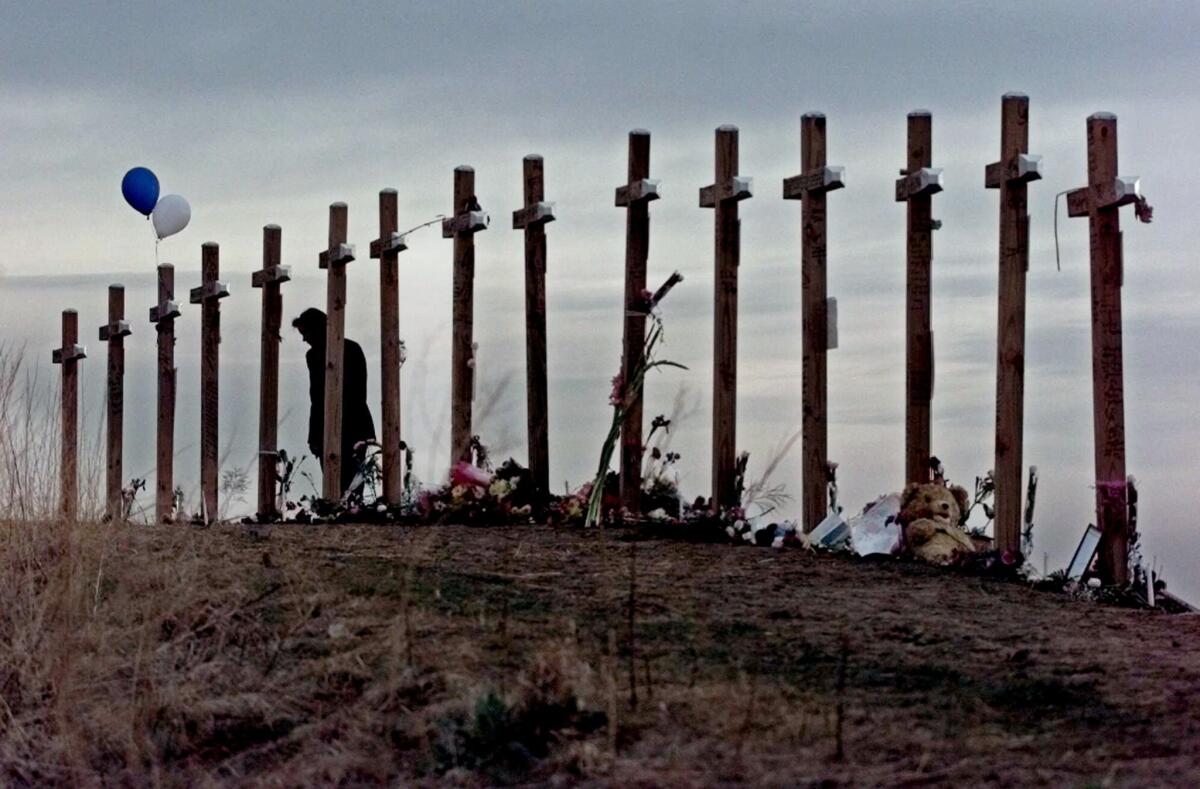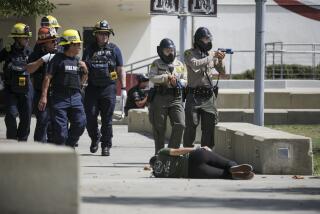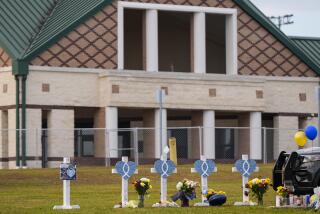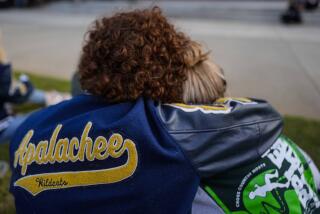Columbine shooting continues to cast shadow over schools

JEFFERSON COUNTY, Colo. — As she does every day, Kay Cates asked her 10-year-old son how his school day went. He shrugged.
“We did math. We did reading. We had a lockdown,” the Boulder fourth-grader replied.
She froze. When pressed, the boy matter-of-factly explained the protocol he has rehearsed since kindergarten: “We hid so in case a man with a gun came he can’t find us.”
FOR THE RECORD:
School shootings: An article in Section A on Dec. 18 about training children how to respond if a gunman attacks a school misspelled the last name of the founder of a group called Moms Demand Action for Gun Sense in America. She is Shannon Watts, not Watt. —
That was Dec. 4. Nine days later, across the Denver metro area in Centennial, a man with a gun came to Arapahoe High School. Karl Halverson Pierson, 18, shot and gravely wounded another student before taking his own life. It was at least the fourth school shooting incident in the Denver area since 1999, starting with Columbine High School.
And that doesn’t include the Aurora theater rampage in 2012, which left 12 people dead and 70 others injured.
For schoolchildren born into post-Columbine America, the idea that they must prepare for bad people who open fire in classrooms, school libraries and playgrounds has become routine.
“It struck me that this is now just part of his life,” said Cates, a mother of four children ranging in age from 4 to 16. “I think about how my children are going to grow up and think this is a normal part of school.”
That’s when a little piece of her heart breaks.
According to an analysis of data from the Brady Campaign to Stop Gun Violence, there have been at least 285 school shooting incidents across the country since April 20, 1999. That was the day two heavily armed high school seniors, Dylan Klebold and Eric Harris, forever altered school safety in this country by killing 12 students, a teacher and themselves at Columbine.
Although there had been school shootings before, Columbine is seen as a national point of demarcation. Law officers were roundly criticized for failing to act quickly, leaving students trapped and vulnerable, said Kenneth Trump, president of Ohio-based National School Safety and Security Services, a consulting firm that works with school districts across the country.
“Columbine made school security and preparedness part of the educational culture,” he said.
Sachin Mathur, an 18-year-old college freshman who grew up in Castle Rock, Colo., was in kindergarten in the immediate aftermath of Columbine. Throughout his school years, lockdown drills became routine.
“Living in the shadow of Columbine and the Aurora theater shooting,” Mathur said, he worried, “Can it be my school next?”
Columbine is just 12 miles from Rock Canyon High School, where Mathur graduated. The Aurora theater is 15 miles away; Arapahoe is six.
Teaching too has changed in the post-Columbine reality.
Lisa Lane Filholm, a 45-year-old veteran teacher, quit this year to spend more time with her family. She remembers a deadly shooting on Sept. 27, 2006, at Platte Canyon High School in Bailey, Colo., not far from where she taught.
“I realized at that moment that this is not what I signed up for, to be a first responder, to be on the front lines,” she said. “This career is dangerous. Or it could be.”
In that incident, an intruder entered the school, took six girls hostage, sexually assaulted some of them, then shot and killed 16-year-old Emily Keyes before killing himself.
Filholm immediately reassessed where her desk was located and how she could best protect her students. Back-to-school orientation for teachers now includes safety drills on how to respond to a gunman. In addition, most schools conduct two or three lockdown drills for students in all grades.
Every state has a different level of preparedness, Trump said, but for Coloradans, the stakes seem higher.
“Time and distance from high-profile incidents fuel complacency and denial,” he said. “When major incidents happen in your own backyard, people take it a lot more seriously and remember them for a longer period of time.”
After the mass killings a year ago at Sandy Hook Elementary School in Newtown, Conn., where 20 children and six educators were slain, some argue that drills aren’t enough. School administrators and teachers should be armed, these critics contend, and even children should be taught to fight back.
The U.S. Department of Education suggested this year that school staff can run away, hide or fight back when threatened by an “active shooter.”
“As a last resort when confronted by the shooter, adults in immediate danger should consider trying to disrupt or incapacitate the shooter by using aggressive force and items in their environment, such as fire extinguishers and chairs,” the new guidelines say.
Trump said he knew of one school that urged children to hide soup cans in their desks so they can hurl them at a gunman. He calls that strategy abhorrent and potentially deadly for any child trying to combat semiautomatic gunfire with a can.
“That is horrifying,” said Shannon Watts, a mother of five who started a grass-roots advocacy group called Moms Demand Action for Gun Sense in America the day after Sandy Hook. “If that is where we are at in this country, it’s a pretty sad state of affairs.”
Still, precautions are so ingrained in today’s childhoods that they have become second nature.
When Whitney Riley heard the first loud bang of gunfire last week near the Arapahoe High School study center, she knew to run to a place of safety. Whitney, 15, six other students and two teachers crammed into a tiny sprinkler systems room, no bigger than a closet. Her mind raced through the years of drills.
She weighed her options: Would she confront the gunman? Would she run? Would she stop to help the wounded? Would she sacrifice her life? She heard someone yell, “Get out!” and remembered the stories of the Columbine killers taunting and stalking their victims. She stayed put until a teacher told her to run.
Her father, Charles Riley, said Whitney also attended Deer Creek Middle School, site of a 2010 suburban Denver school shooting. He finds no comfort in statistics that say school shootings are extraordinarily rare.
“I’m very proud of her,” he said, with a mixture of awe and horror at what his daughter has learned and endured in her young life. He said she and her brother, who also attends Arapahoe High School and knew the shooter, are doing well despite last week’s events.
He and his wife, not so much: “We’re still trying to figure out what to feel.”
Times staff writer Soumya Karlamangla in Los Angeles contributed to this report.
More to Read
Sign up for Essential California
The most important California stories and recommendations in your inbox every morning.
You may occasionally receive promotional content from the Los Angeles Times.










